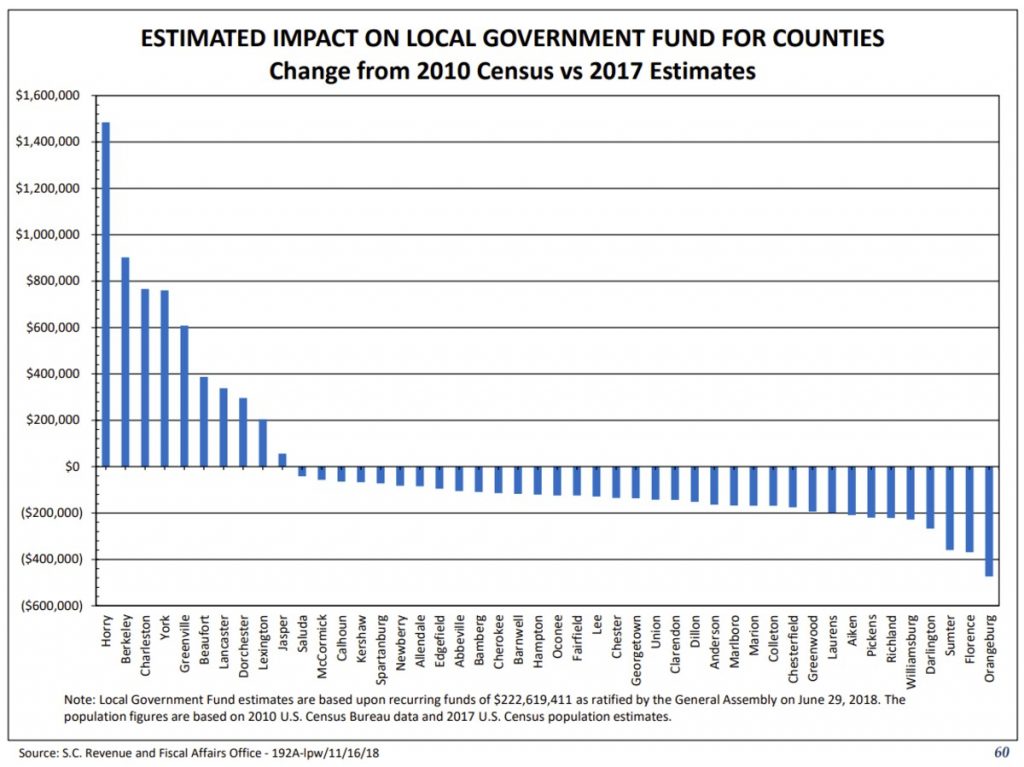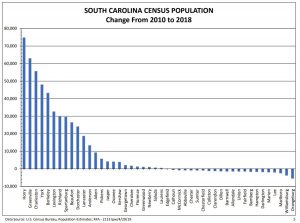
By Lindsay Street, Statehouse correspondent | Four in five counties and municipalities in South Carolina could see a revenue losses following the 2020 Census, according to an analysis by the state Revenue and Fiscal Affairs Office.
Why? Because the state divvies up money among local governments on a per capita basis instead of using a broader measure. While 10 counties and 51 cities are expected to show growth since 2010, 78 percent of counties and 81 percent of cities saw either a decrease or relatively the same population since 2010, according to 2017 U.S. Census Bureau estimates.
If projected population estimates hold true for the 2020 Census, counties — which get the largest share of state dollars to fund state-mandated services at the county level — could see cuts anywhere from $50,000 in Saluda County to more than $400,000 in Orangeburg County. Of the 10 counties that will see an increase in revenue, Jasper County could see a $50,000 increase and Horry County could see a $1.5 million increase, according to a February RFA presentation to the S.C. Association of Auditors, Treasurers and Tax Collectors. Over the summer, a second, similar presentation was made to the Municipal Association of South Carolina.
“Generally, the same areas (as in the 2010 Census that) are growing,” RFA Executive Director Frank Rainwater told Statehouse Report. “You see the urban areas growing and the rural areas not growing as fast … It’s a budget issue to be considered.”
And it could be addressed at the state level. House Ways and Means Committee Chair Murrell Smith, R-Sumter, is from one of those counties facing a decline. Estimates show Sumter County potentially losing more than $300,000.
“It is on my radar … Rural counties are struggling and the last thing we need to do is start taking away money as a result of stagnant or declining growth,” Smith said. But he added, “we have time to deal with it.”
Smith sponsored a law passed earlier this year that revamped the local government funding formula that allowed it to grow or decrease along with predicted state revenue growth.
Smith said he has been in talks with Rainwater over the impacts of potential Census changes, and he expects a legislative debate to come up before 2021 budget-writing.
How funding could impact some local governments
Think of the local government fund as a pie, Rainwater said. If all the pieces of the pie are sized in proportion to population and one slice’s population grows, then because the pie can’t get any bigger, another slice becomes smaller.
And that can cause serious concern among the state’s county and municipal leaders.
“It’s scary for some cities. There are some very small towns that don’t have a property tax and they don’t have a large revenue stream,” Municipal Association of South Carolina research and legislative liaison Melissa Harrill said.

In Florence County, a loss of $300,000 in revenue is predicted for its 2021-2022 fiscal year. This fiscal year, the county’s budget stood at $61 million. Florence County Administrator K.G. Rusty Smith said the loss of money could make it even harder for the county to fulfill its “basic function” of “protecting lives and property.”
“We’ve all experienced problems in being able to keep personnel based on giving cost-of-living raises,” he said. And $300,000 may be the difference-maker in the county being able to afford higher wages, he added.

Two counties away in fast-growing Berkeley County, there is a projected increase of about $800,000 to its $91 million budget. At times over the last 10 years, Berkeley County has ranked in the top 20 counties nationally in terms of growth.
“We will see some explosive growth from 2010,” Berkeley County Finance Director Allen Milburn said. “(But) the local (government fund) itself increasing is kind of negligible to our total budget.”
He said it was still “a little premature” to tell exactly how Berkeley County will fare until after the Census is completed.
‘Being counted’
 Mailboxes across the country will begin receiving Census surveys in March. Then, there will be follow-up mailings.
Mailboxes across the country will begin receiving Census surveys in March. Then, there will be follow-up mailings.
In Florence County, there was low participation in 2010, Smith said. And the county is already gearing up to push for an accurate count in 2020.
“We don’t feel like Florence County is losing population,” Smith said of the 2017 Census estimates. “We’re going to put together a ‘complete count’ committee.”
Harrill said her association is working with municipalities to drive participation.
“Now comes the next step of educating the population how important filling it out is,” Harrill said.
Rainwater said the predicted budget hits “all goes back to the importance of everyone standing up and being counted.”
- Have a comment? Send to: feedback@statehousereport.com
















 We Can Do Better, South Carolina!
We Can Do Better, South Carolina!
The translation of these reduction numbers into the impact on individual communities is revealed in “The Land of Self-Defeat.” It is complicated.
https://www.nytimes.com/2019/10/04/opinion/sunday/trump-arkansas.html?action=click&module=Opinion&pgtype=Homepage#commentsContainer